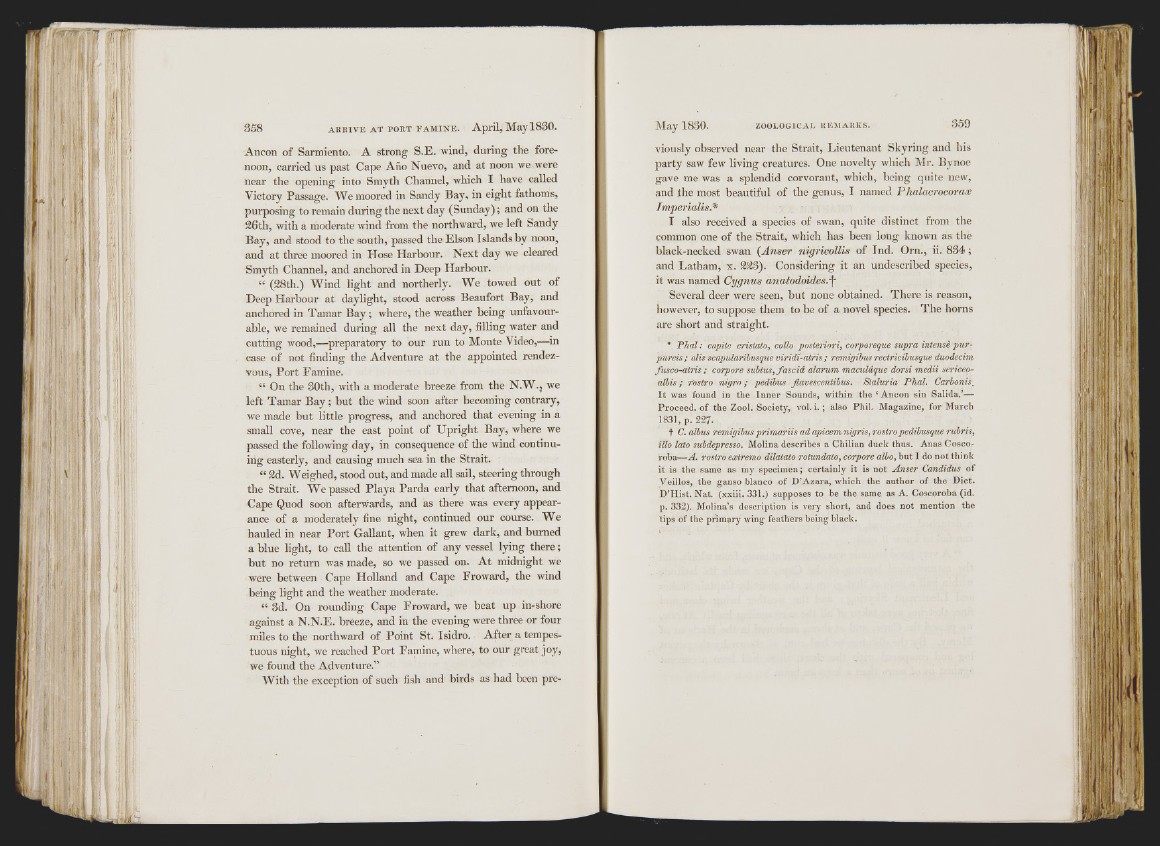
Ancon of Sarmiento. A strong S.E. wind, during the forenoon,
carried us past Cape Año Nuevo, and at noon we were
near the opening into Smyth Channel, which I have called
Victory Passage. We moored in Sandy Bay, in eight fathoms,
purposing to remain during the next day (Sunday); and on the
26th, with a moderate wind from the northward, we left Sandy
Bay, and stood to the south, passed the Elson Islands by noon,
and at three moored in Hose Harbour. Next day we cleared
Smyth Channel, and anchored in Deep Harbour.
“ (28th.) Wind light and northerly. We towed out of
Deep Harbour at daylight, stood across Beaufort Bay, and
anchored in Tamar Bay; where, the weather being unfavourable,
we remained during all the next day, filling water and
cutting wood,—preparatory to our run to Monte Video,—in
case of not finding the Adventure at the appointed rendezvous,
Port Famine.
“ On the 30th, with a moderate breeze from the N.W., we
left Tamar Bay; but the wind soon after becoming contrary,
we made but little progress, and anchored that evening in a
small cove, near the east point of Upright Bay, where we
passed the following day, in consequence of the wind continuing
easterly, and causing much sea in the Strait.
“ 2d. Weighed, stood out, and made all sail, steering through
the Strait. We passed Playa Parda early that afternoon, and
Cape Quod soon afterwards, and as there was every appearance
of a moderately fine night, continued our course. We
hauled in near Port Gallant, when it grew dark, and burned
a blue light, to call the attention of any vessel lying there;
but no return was made, so we passed on. At midnight we
were between Cape Holland and Cape Froward, the wind
being light and the weather moderate.
“ 3d. On rounding Cape Froward, we beat up in-shore
against a N.N.E. breeze, and in the evening were three or four
miles to the northward of Point St. Isidro. After a tempestuous
night, we reached Port Pamine, where, to our great joy,
we found the Adventure.”
With the exception of such fish and birds as had been pre/
" i ' i ; If:
viously observed near the Strait, Lieutenant Skyring and his
party saw few living creatures. One novelty which Mr. Bynoe
gave me was a splendid corvorant, which, being quite new,
and the most beautiful of the genus, I named Phalacrocorax
Tmperialis.*
I also received a species of swan, quite distinct from the
common one of the Strait, which has been long known as the
black-necked swan {Anser nigricoUis of Ind. Orn., ii. 834;
and Latham, x. 223). Considering it an undescribed species,
it was named Cygnus anatodoides.-f
Several deer were seen, but none obtained. There is reason,
however, to suppose them to be of a novel species. The horns
are short and straight.
* F h a l: capite a-istato, collo posteriori, corporeque supra intense p u r p
uréis; alis scapulariimsque viridi-atris ; remigibus rectricibusque duodecim
fusco-atris : corpore subtus, fa s c ia alarum maculdque dorsi medii sericeo-
albis; rostro n ig ra ; pedibus flavescentibus. Staluria Plial. Carbonis.
I t was found in the In n e r Sounds, within the ‘ A ncon sin Salida.’—
Proceed, of the Zool. Society, vol. i . ; also Phil. Magazine, for March
1831, p. 227.
t C. albus remigibus prim ariis ad apicem nigris, rostro pedibusque ruhris,
illo lato subdepresso. Molina describes a Chilian duck thus. Anas Coscoroba—
A . rostro extremo dilatato rotundato, corpore albo, b ut I do n ot think
it is the same as my specimen; certainly it is not Anser Candidas of
Veillos, the ganso blanco of D ’Azara, which the author of the Diet.
D’H ist. Nat. (xxiii. 331.) supposes to be the same as A. Coscoroba (id.
p. 332). Molina’s description is very short, and does not mention the
tips of the primary wing feathers b eing black.